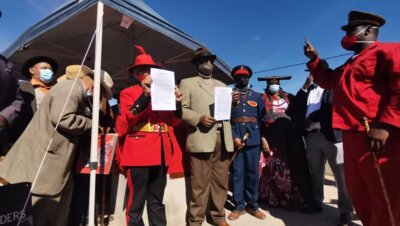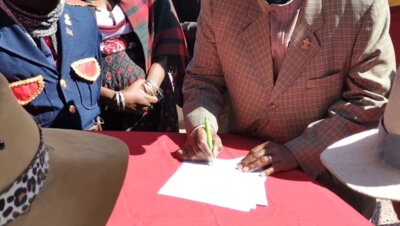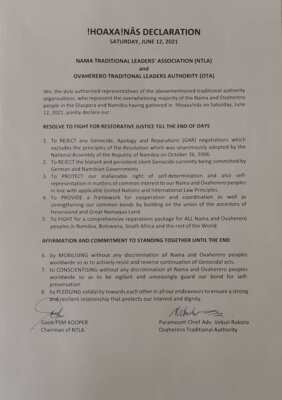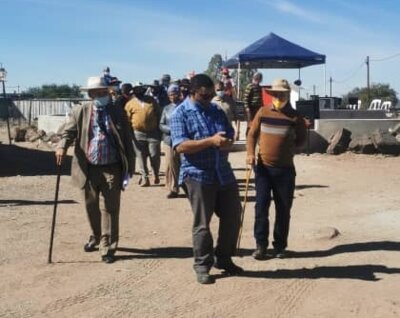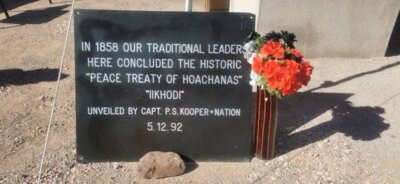Hoachanas Vertrag (12. 06. 2021)
Historical Background
1. The pre-historical period from 30,000 B.C. to about 1480 A.D. of today’s Namibia does not have historical written records, but the rock art in the vicinity of Bethanie which is believed to be dating back to 27,000 B.C. as reported by Wolfgang Wendt is an indication of our prehistoric times. Another clue is provided by The Times: The World an Illustrated History (page 248), indicating that Khoisan language was spoken 3,000 - 2,000 B.C. in southern and eastern Africa, the Nama and !Kung languages emerged around 1,000 A.D. in southern Africa, specifically in today’s Namibia.
2. The Nama people had encounters with European nations prior to the eventual genocide. First the Portuguese in around 1480, followed by the Dutch around 1650, later the British and finally the Germans in the late 1800’s.
3. Prior to German colonisation, Namaqua people had thirteen (13) sub-tribes, each tribe governed by their Gaob or Gaos and his/her Council on their territory whilst overall Great Namaqualand was governed by Confederation (similar to a federal system) which was confirmed by the Hoaxanas Treaty of 09 January 1858. Commissioner William Coates Palgrave of Cape Government met with leaders of Hereroland and Namaland nations in the year 1876 to hear their wishes regarding political sovereignty - both nations stand firm to safeguard their sovereignty.
4. The refusal of Gaob Hendrik Witbooi to sign a protection treaty with Imperial Germany, led to the first genocide on 12 April 1893 in Hornkranz committed under the instructions of Curt von Francois against the Witbooi tribe. Lothar von Throta’s extermination orders 02 October 1904 against the OvaHerero people and 22 April 1905 against the Nama people was simply a continuation of what already started in 1893.
5. We are gathered today in Hoachanas, the settlement of the Kai//Khau //Aes. Interestingly, the European historian’s translation of the name of the tribe is the Great Defenders. There was a time in which the Gaob or Gaos of Kai//Khau //Aes had to lead the Red Nation. The Red Nation consisted of: a. Kai//Khaun of Gaob Kooper b. //Khau/gôan of Gaob Luipert c. !Khar’khoen of Gaob Hanse d. !Khar’/gôan (also known as Kharo!oan or Tseib tribe) registered under Blouwes Traditional Authority currently led by Senior Councillor Johannes Baarman e. //Haboben also registered under Blouwes Traditional Authority f. //Ōkain also known as Grote Dode which is currently not registered as traditional authority
6. The !Gami#nûn tribe close to the Orange river and the !Naranin / #Aonin / !Gomen where based along the Atlantic Ocean in today’s Erongo and Kunene regions.
7. The encounters with European nations resulted in more Nama sub-tribes, which was then based in Small Namaqualand (part of today’s South Africa) to cross the Orange River and joining their brothers and sisters in Great Namaqua Land. This movement started from //Hui!gaeb (today’s Cape Town) with the crossing happening in the late 1700’s. We observe that there are others in Namibia, like the Ancestral Land Commission who think that Nama people came for the first time in 1700’s into Namibia because they are determine to rewrite the history of Namibia.
8. The Nama sub-tribes that came in from Small Namaqualand are: a. /Hôa/aran //Aixa //Aes (Gaob Afrikaner’s tribe) b. !Aman //Aes (Gaob Frederick’s Bethanie tribe) c. Kai /Khauan (Lambert’s tribe in Gobabis) d. /Khauan (Gaob Isaack’s tribe in Berseba) e. /Khobesen (Gaob Witbooi’s tribe in Gibeon)
9. The Nama sub-tribes of Small Namaqualand had a fair understanding of the European nations and found it necessary to protect the sovereignty of Great Namaqualand. In 1856, Gaob Afrikaner and Gaob //Oaseb met at Cross Baarman in Okandja that led to the eventual signing of the Hoachanas Treaty on 09 January 1858.
10. The conference was held at this very venue and the Hoachans Treaty and signed on 09 January 1858 by all Great Namaqua leaders of the time. The OvaHerero Royal House of Hereroland and Griqua Royal House of Griqualand was also present at the meeting.
11. The relationship between the Nama and OvaHerero people has been built and strengthen ever since. A crime of Genocide was committed against these two nations by Imperial Germany and we are determined to face and overcome the horrible crimes committed against our ancestors. Our gathering today is focused to celebrate and fight for selfperseverance.
I thank you.
Gaob Isaack
Urheberrecht:
Nama Traditional Leaders Association









